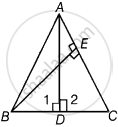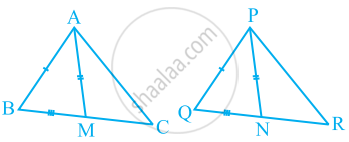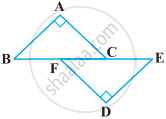Advertisements
Advertisements
प्रश्न
ABC is an isosceles triangle in which AC = BC. AD and BE are respectively two altitudes to sides BC and AC. Prove that AE = BD.
उत्तर
Given: ΔABC is an isosceles triangle in which AC = BC.
Also, AD and BE are two altitudes to sides BC and AC, respectively.

To prove: AE = BD
Proof: In ΔABC,
AC = BC ...[Given]
∠ABC = ∠CAB ...[Angles opposite to equal sides are equal]
i.e., ∠ABD = ∠EAB ...(i)
In ΔAEB and ΔBDA,
∠AEB = ∠ADB = 90° ...[Given, AD ⊥ BC and BE ⊥ AC]
∠EAB = ∠ABD ...[From equation (i)]
And AB = AB ...[Common side]
∴ ΔAEB ≅ ΔBDA ...[By AAS congruence rule]
⇒ AE = BD ...[By CPCT]
Hence proved.
APPEARS IN
संबंधित प्रश्न
ABC is a right angled triangle in which ∠A = 90° and AB = AC. Find ∠B and ∠C.
AD is an altitude of an isosceles triangles ABC in which AB = AC. Show that
- AD bisects BC
- AD bisects ∠A
Two sides AB and BC and median AM of one triangle ABC are respectively equal to sides PQ and QR and median PN of ΔPQR (see the given figure). Show that:
- ΔABM ≅ ΔPQN
- ΔABC ≅ ΔPQR

In two right triangles one side an acute angle of one are equal to the corresponding side and angle of the other. Prove that the triangles are congruent.
Prove that in a quadrilateral the sum of all the sides is greater than the sum of its diagonals.
In the following figure, BA ⊥ AC, DE ⊥ DF such that BA = DE and BF = EC. Show that ∆ABC ≅ ∆DEF.

ABC and DBC are two triangles on the same base BC such that A and D lie on the opposite sides of BC, AB = AC and DB = DC. Show that AD is the perpendicular bisector of BC.
Two lines l and m intersect at the point O and P is a point on a line n passing through the point O such that P is equidistant from l and m. Prove that n is the bisector of the angle formed by l and m.
ABC is a right triangle such that AB = AC and bisector of angle C intersects the side AB at D. Prove that AC + AD = BC.
ABCD is quadrilateral such that AB = AD and CB = CD. Prove that AC is the perpendicular bisector of BD.
